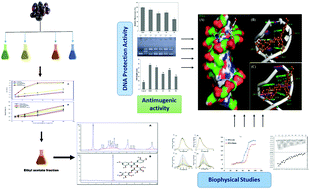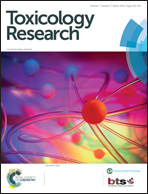Genotoxicity inhibition by Syzygium cumini (L.) seed fraction and rutin: understanding the underlying mechanism of DNA protection†
Abstract
Considering the ethnopharmacological importance of Syzygium cumini's seed and the lack of information on the antimutagenic and DNA-protecting mechanisms, a fraction-based study was conducted. Four different (hexane, chloroform, ethyl acetate, and aqueous) fractions were obtained from the sequential extraction of the methanolic extract of the seed. The most active antioxidant fraction (ethyl acetate) contained significant amount of phenolics and flavonoids. LC-qTOF-MS analysis of the ethyl acetate fraction revealed the presence of rutin, myricetin, naringin, cuscohygrin, and epoxycarryophyllone as constituent phytocompounds. The ethyl acetate fraction (100 μg ml−1) and a selected compound (rutin, 40 μg ml−1) showed remarkable decrease in the revertants frequency range from 74–77% and 66–84%, respectively, against both the mutagens (sodium azide (NaN3) and methyl methane sulfonate (MMS)) in the Salmonella typhimurium tester strains. All the statistical analyses were at a significance level of 0.05 between the different treatment groups. Moreover, the underlying mechanism of antimutagenicity using different treatment regime for rutin was explored. MMS-mediated DNA fragmentation and oxidation in lymphocytes were also shown to be decreased significantly when treated with the ethyl acetate fraction and rutin. Oxidative damage to pBR322 plasmid DNA was also reduced when incubated with different concentration of the ethyl acetate fraction and rutin. Biophysical (UV, fluorescence, ITC, etc.) and computational methods were employed to obtain a closer look at the DNA–rutin interaction. The data obtained clearly revealed that the ethyl acetate fraction exhibited promising antimutagenic and DNA-protective activity and its flavonoid constituents, including rutin, contribute significantly to the observed activity.



 Please wait while we load your content...
Please wait while we load your content...